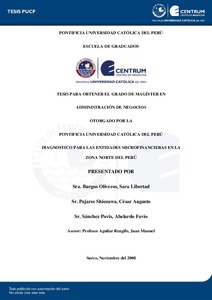Diagnóstico para las entidades microfinancieras en la zona norte del Perú

View/
Date
2012-12-04Author
Burgos Oliveros, Sara Libertad
Pajares Shiozawa, César Augusto
Sánchez Povis, Abelardo Favio
Metadata
Show full item recordAbstract
El presente estudio propone alternativas para las Instituciones Microfinancieras del Norte del Perú, como respuesta a la incursión de nuevos competidores en el sector microfinanciero. La implementación de éstas les permitirá seguir siendo entidades viables, capaces de afrontar con éxito la actual coyuntura y posibles escenarios posteriores.
Por lo tanto, la creación y mejora de productos, servicios, canales y puntos de atención, búsqueda de nuevos segmentos, nichos de mercados, implementación de programas de fidelización de clientes, cambios en los procesos internos (con una normatividad más flexible por parte de los entes supervisores y reguladores), entre otras, son variables indispensables para que las Instituciones Microfinancieras puedan seguir apoyando de una manera sostenible a un gran sector de la población del país.
En los últimos años, el ingreso de la Banca y de otras entidades financieras a este sector del mercado han demostrado ser una opción adicional de financiamiento para los microempresarios y clientes potenciales. Pero, no necesariamente han hecho crecer a este mercado, sino que desde que iniciaron sus operaciones, tan sólo tomaron un porcentaje del que ya existía en las carteras de las entidades microfinancieras especializadas. Este porcentaje ha seguido aumentando a través de diversas estrategias, tales como campañas de atracción a los mejores clientes, reclutamiento del personal calificado y con gran experiencia en este sector (perteneciente a las entidades microfinancieras que, con anterioridad, fueron la única alternativa de apoyo de las pequeñas y medianas empresas), etc.
Por otro lado, de acuerdo a la información brindada por la Superintendencia de Banca, Seguros y AFPs y el Banco Central de Reserva del Perú, a diciembre 2007, se observa que la variación en las operaciones financieras dentro del sector financiero nacional ha evolucionado de manera más notoria en la zona norte del país. Esto debido al desarrollo y crecimiento de los diversos sectores de la economía. Es precisamente en los departamentos de La Libertad, Piura, Lambayeque y Tumbes donde se hace más notorio este hecho. Asimismo, a diciembre del mismo año, el grado de bancarización evoluciona en mayores porcentajes en los mismos departamentos: La Libertad, 13%; Lambayeque, 16%; Piura, 18% y Tumbes, 19%.
Finalmente, el desarrollo del presente Análisis Estratégico se ha sustentado en la aplicación de herramientas estratégicas, tales como el Modelo de la Cinco Fuerzas de Michael Porter y el Análisis Externo e Interno, orientados en este caso al Sector Microfinanzas. Si bien la Metodología aplicada es de carácter descriptivo, los resultados obtenidos permiten sugerir algunas alternativas de referencia para las Entidades Microfinancieras, de forma tal que las aprovechen en su crecimiento y desarrollo, especialmente ante el ingreso de la Banca y otros Competidores en el Sector Microfinanciero de la Zona Norte del Perú. The following research study proposes alternatives for the Micro-financial Institutions of the Northern Peru, as a response to the arrival of new competitors in the micro-financial sector, and this way continue being considered as viable entities that successfully face the environment in which they perform and possible future scenarios. Therefore, the creation and improvement of new products, services, sources of attention, seek of new segments, new market possibilities, setting of new loyalty programs of clients, changes in the intern processes, and trusting in newer and more flexible norms by the supervising and regulating entities, among others; are important variables for the Micro-financial Institutions to continue supporting this huge sector of population of the country.
In the last few years, the Banking income and of other financial entities from this sector have demonstrated to be an additional option of financing for the small companies and potential clients; but they did not necessarily create the increase of this market; however, since they started operations, they have taken a small percentage from the already existing one in benefit of the portfolios of the specialized micro-financial entities, which, as part of their strategies, have increased by using campaigns for capturing the best clients, the recruiting of qualified personnel, who have experience in the field and who belong to micro-financial entities; the ones that were before the only alternative of support of the small and medium-sized companies.
On the other hand, according to the offered information by Supervision of Bank, Securities and AFP’s and the Central bank of Reserve of Peru, to December 2007, it is observed that the variation of the financial operations within the national financial sector have evolved notoriously in the northern part of the country, because of the development and growth of the diverse economical sectors, the same that can be seen in departments such as La Libertad, Piura, Lambayeque and Tumbes. Likewise, the degree of banking has increased its percentage in the same departments: La Libertad 13%, Lambayeque 16%, Piura 18% and Tumbes 19%.
Finally, the development of the present Strategic Planning had been based on the application of strategic tools, like the Model of the Five Strengths of Michael Porter and the External and Internal Analysis, all of them oriented to the performance of this study of the Micro-financial Sector. The applied Methodology is descriptive, which helped the reach of conclusions and results and pretends suggesting some referential alternatives for the Micro-financial Entities in its growth and development, before the arrival from the banking and Other Competitors in the Micro-Financial Sector of the Northern Area of Peru.
Temas
Microfinanzas--Perú.
Instituciones financieras--Perú.
Instituciones financieras--Perú.
Para optar el título de
Maestro en Administración de Negocios





